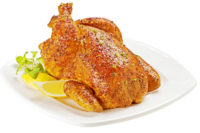
Looking back over 2009, it was a year that had many interesting developments in terms of adjusting production to a new level of domestic consumer demand, dealing with potential and significant export disruptions to the two largest markets, mandatory country-of-origin labeling, a new player becoming the owner of major broiler company, and the list goes on. Despite the many developments, the bottom line for most companies was a year of relief from negative net margins that had persisted during 2008, if not before last year. This year can be characterized as somewhat like Goldilocks described her favorite porridge: not too hot and not too cold.
Although next year could be a close repeat of 2009, there will be one favorable development that will be unlike the situation since 2007.
After three consecutive years of experiencing decreases in per capita consumption, the broiler industry will have at least one major positive measure in 2010, that is, an increase in per capita consumption. USDA is projecting a 0.9- to 1.2-pound increase in broiler consumption, but the National Chicken Council anticipates a somewhat more robust gain of 1.5 pounds or more in 2010. After dropping 3.0 pounds in 2009 and a combined six pounds from 2006-2009 (see the USDA Annual Broiler Forecasts chart below), the rebound in consumption will undoubtedly renew confidence in many broiler marketers that the three-year decline was not a portent for a long-term trend in poultry consumption that happened to beef consumption starting in 1976. Rather, as the broiler industry moves in to 2010 and looks at the past three years in the rear-view mirror, companies will see this time as a pause or time-out so that demand and supply adjusted to align in a better balance and improve the industry’s position to address the new realities in the marketplace, both at-home and abroad.
To achieve a 1.5-pound or better increase in consumption next year, as NCC anticipates, the step-up in broiler production in 2010 will have to be measurably more than the 1.5 percent USDA forecasts. An increase in production of 2.0 percent is more likely and could be slightly higher if broiler exports in 2010 improve beyond current expectations.
The broiler hatchery supply flock for first quarter 2010 implies a continued reduced level of broiler production through first half 2010. Although there is some usual slippage in the hatchery supply flock data, this leading indicator does strongly suggest continued discipline on the part of broiler companies. At the same time, despite a cold, wet Spring 2009 planting season for the U.S. corn and soybean crops, this past summer growing season has provided favorable conditions for a bumper harvest of corn and soybeans. Feed costs should remain somewhat below the levels experienced in recent years, albeit not as low as before the Fall of 2006 when government-subsidized ethanol drove corn prices to high, unprecedented levels. Even with good corn and soybean crops this year, all users of grains and oilseeds will be keeping a watchful eye on the planting, growing, and harvesting of corn and soybeans in 2010. Carry-over inventories of these crops will be adequate and not so burdensome that a poor harvest in 2010 could be bolstered by the carry-over inventory. Also in the mix for next year is the changing level of competition from beef and pork. The cattle industry next year and, perhaps until 2013 if not longer, will continue to wind down the number of steers and heifers available for feedlots. With the cattle cycle in its down phase, it will be difficult for beef prices to not become more of a challenge to food shoppers’ budgets. Much will depend on the strength and timing of the U.S. economy recovery and more employed workers feeling confident to loosen their purse-strings at the supermarket meat department and their favorite restaurants.
Pork producers have sustained more than two years of monthly losses with only a few exceptions. Steady gains in the hog industry’s productivity have offset much of the decline in sow numbers, and that conclusion may continue to prove true next year, too. Lost pork exports means more pounds of pork on the domestic market and more competition for poultry for most of 2010.
As the economy recovers and the likelihood of increased broiler consumption becomes more apparent, it is reasonable to expect a new wave of innovative, value-added chicken products to help capture more eating occasions at breakfast, lunch, dinner and snack for both the at-home and away-from-home markets. On the supply side, an abundance of boneless/skinless breast meat will also be an incentive for broiler companies to find successful new products that feature this part of the bird.
Broiler exports in certain years tend to be a wild card, and 2010 will be a year when the wild card could again be played. In 2008, over 19 percent of broiler production was exported, a record high share. This year the share will likely register at just under 19 percent before declining below 18 percent in 2010. Nonetheless, U.S. broiler exporters remain cautiously optimistic that exports in 2010 can contribute to a year that, from a bottom-line standpoint, will be not too cold and not too hot. As Goldilocks would say, “This porridge is just right.”



Report Abusive Comment